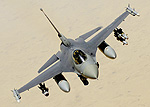Lockheed Martin Awarded $30 Million Contract to Provide Sniper Advanced Targeting Pods to Royal Moroccan Air Force
 ORLANDO, FL, September 24th, 2009 - Lockheed Martin [NYSE: LMT] has signed a foreign military sales contract to deliver Sniper® Advanced Targeting Pods (ATPs) to the Royal Moroccan Air Force. The $30 million contract includes integration support, product spares and logistics support. The Sniper ATPs will fly on the Royal Moroccan Air Force’s newly-purchased F-16 block 50 aircraft.
ORLANDO, FL, September 24th, 2009 - Lockheed Martin [NYSE: LMT] has signed a foreign military sales contract to deliver Sniper® Advanced Targeting Pods (ATPs) to the Royal Moroccan Air Force. The $30 million contract includes integration support, product spares and logistics support. The Sniper ATPs will fly on the Royal Moroccan Air Force’s newly-purchased F-16 block 50 aircraft.
“The Royal Moroccan Air Force selected the Sniper ATP for its unmatched ability to provide precision targeting, as well as its non-traditional intelligence, surveillance and reconnaissance (NT-ISR) capability,” said Hulan Woods, program manager of Sniper ATP Morocco at Lockheed Martin Missiles and Fire Control. “We look forward to working with the Royal Moroccan Air Force to provide the multi-mission capable Sniper pod for their F-16 aircraft.”
Packaged in a single lightweight pod, Sniper ATP’s enhanced image clarity provides critical long-range positive identification of targets and real-time targeting. Its state-of-the-art tracker enables employment of advanced laser-guided weapons against moving targets. Sniper ATP also incorporates meta-data in every frame of video to ensure accuracy throughout intelligence and command and control functions.
The Sniper pods will include a video down link that relays high-resolution, streaming video to forward-deployed forces for non-traditional ISR and rapid target coordination via the widely-used Rover ground receiver. The Royal Moroccan Air Force will take delivery of Sniper pods over the next two years to support aircraft integration and fielding.
Deployed in theater since January 2005, Sniper ATP is in service with the U.S. Air Force, Air National Guard and 11 international air forces and coalition partners.
The Sniper pod is operational on U.S. Air Force, Air National Guard and multinational F-16, F-15, B-1, F-18, Harrier, A-10 and Tornado aircraft. It is currently being integrated and is flying on the B-52. Its common software and hardware interface design enables users to “plug and play” across services and multiple platforms, providing a common software and hardware configuration across aircraft fleets.